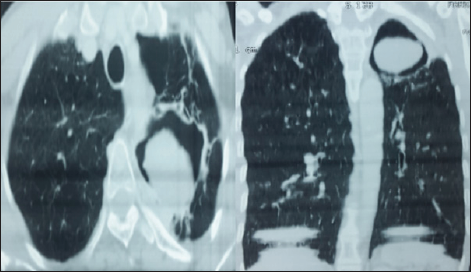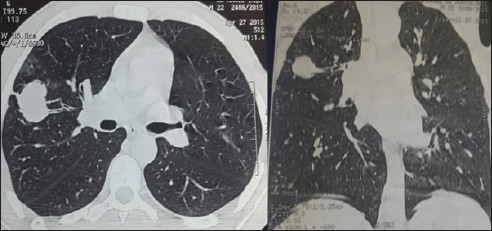Impact Factor : 0.548
- NLM ID: 101723284
- OCoLC: 999826537
- LCCN: 2017202541
M Lakranbi1,2, H Harmouchi*1, L Belliraj1, FZ Ammor1
Received: September 26, 2018; Published: October 05, 2018
*Corresponding author: H Harmouchi Hicham, Thoracic surgery department, CHU Hassan II of Fez-Morocco
DOI: 10.26717/BJSTR.2018.09.001837
Introduction: Pulmonary aspergilloma is the colonization by a fungus of the genus Aspergillus fumigatus in a pulmonary cavity most often preexisting of tuberculous origin. Surgery is the basic treatment with anatomical lung resection. However, wedge resection is possible especially in simple aspergilloma. The purpose of this study is to report the indications to perform wedge resection and compare it to the literature review.
Material and Methods: This is a retrospective study, done within our department of thoracic surgery over a period of 8 years, collecting all the patients who had a pulmonary aspergilloma, and whose intervention was a wedge resection.
Result: It was 11 men and one woman, with an average age of 44.5 years. The history of pulmonary tuberculosis was found in 7 patients (58.3%). Hemoptysis was present in all patients (100%). The radiological assessment showed right-sided involvement in 7 patients (58.3%), and on the left in 5 patients (41.6%), with an image excavated in 5 patients (41.6%). nodular lesion in 4 patients (33.3%), and a excavated lesion with air crescend in 3 patients (25%). With the exception of one patient who was treated with video-assisted thoracic surgery, the approach was conservative posterolateral thoracotomy in all patients. The intervention was by wedge resection in all patients. The postoperative course was simple in all patients. The mean follow-up was 2.5 years, marked by a recurrence of hemoptysis in a single patient who had been treated with embolization.
Conclusion: In pulmonary aspergilloma, wedge resection presents an important alternative to anatomical resections in the case of small and peripheral aspergilloma.
Pulmonary aspergilloma is a form of aspergillosis of the lung that is characterized by the colonization by a saprophytic fungus: Aspergillus fumigatus, of a pre-existing cavity, most often of tuberculous origin. In 1960, Belcher and Plummer established a classification based on clinical and radiological criterion that differentiated simple aspergillomas from complex aspergillomas [1]. Surgery remains the basic treatment in pulmonary aspergilloma, usually by anatomical resection adjusted to avoid the risk of recurrence. However, some cases require a wedge resection especially the forms of simple aspergilloma. The aim of this study is to show the cases where wedge resection is indicated in pulmonary aspergilloma.
This is a retrospective study that collects clinical, paraclinical and operative data from 12 patients operated for pulmonary aspergilloma exclusively by wedge resection. This study took place in the department of thoracic surgery at CHU Hassan II in Fez, from January 2010 to December 2017.
Among 12 patients, there were 11 men and one woman, with an average age of 44.5 years (Table 1). The history of pulmonary tuberculosis was found in 7 patients (58.3%), with a notion of chronic smoking in 2 patients (16.6%). Hemoptysis was the reason for consultation in all patients (100%). Aspergillus serology was requested for all patients, returning positive in only one case (8.3%). The radiological assessment, including chest X-ray and thoracic CT, was performed in all patients, with right-sided involvement in 7 patients (58.3%) and left-sided involvement in 5 patients (41.6%), with a cavitary image in 5 patients (41.6%), a nodular appearance in 4 patients (33.3%), and a lung cavity with an air crescent in 3 patients (25%). In 6 cases (50%), the involvement was at the level of the upper lobes, as well as at the level of the lower lobes (50%). Aspergilloma was peripheral in 10 patients (83.3%) and central localization in 2 patients (16.7%). the approach was a posterolateral conservative thoracotomy for 11 patients, and in one patient it was a video-assisted thoracic surgery. The release of the lung was made through the extrapleural plane in 4 patients (33.3%) due to a very tight pleuropulmonary symphysis. The surgical procedure was conservative in all patients by a wedge resection. The follow-up was simple for all patients, with an average hospital stay of 5 days, and no deaths were reported within 30 days after the intervention. The mean follow-up was 2.5 years, marked by a recurrence of hemoptysis in a single patient who had a complex aspergilloma of the left upper lobe benefiting only of a wedge resection, given the impossibility of performing a upper lobectomy due to very tight pleural symphysis.
Pulmonary aspergilloma is the development of a mycelial fungal infection caused by Aspergillus fumigatus within a pre-existing parenchymal cavity, most often of tuberculous origin [2]. According to the different series, and in our series, tuberculosis remains the most responsible pathology of pulmonary aspergilloma [3-6]. The frequent clinical presentation remains hemoptysis, which may be of low abundance or massive in some life-threatening cases [7]. The typical radiological appearance of pulmonary aspergilloma is a lung cavity with an air crescent [8]. According to the classification of Belcher and Plummer, the complex aspergilloma is most often symptomatic, in patients with general poor condition and nutritionally deficient, also a excavated lesion with perilesional fibrosis, and a pachypleuritis (Figure 1) [1]. However, a simple aspergilloma is seen in asymptomatic patients, without functional or nutritional defects, with radiologically the presence of a parenchymal cavity without be associated of a pleuro-parenchymal abnormality (Figure 2) [1]. The treatment of pulmonary aspergilloma is based on Surgery. The classic approach remains the thoracotomy, because of the importance of pleuro- parenchymal adhesions.
Figure 1: Thoracic CT in axial and frontal section showing complex aspergilloma of the left upper lobe associated with perilesional fibrosis and significant pachypleuritis.

Figure 2: Thoracic CT scan in axial and frontal section showing a single peripheral lesion of the right upper lobe of peripheral location without perilesional fibrosis or pachypleuritis.

However, video-assisted thoracic surgery presents an alternative, especially in simple aspergilloma, or some complex aspergilloma without hilar infiltration [3]. By analyzing the different series presented in Table 2, it is concluded that anatomical resection of the lung remains the basic treatment in pulmonary aspergilloma to avoid the risk of recurrence, and that wedge resection remains an alternative to resection adjusted for simple aspergilloma. According to Marghili et al, a wedge resection can be proposed in simple, peripheral forms with a diameter less than 4cm [5], whereas according to the Ping Yuan et, it can be applied for simple aspergilloma, and some complex forms that sit in the outer third of the lung and are less than 3cm in size [9]. In the case of scissural aspergilloma, especially of central location, wedge resection remains an alternative to pneumonectomy or bilobectomy, which are associated with a high mortality rate. According to the different series, the mortality and morbidity rate are respectively estimated at 6% and 20 to 40% [10]. The main postoperative complications are hemothorax, pyothorax, prolonged air leak, and postoperative pneumonia.
The risk of these complications increases significantly in complex aspergilloma benefiting of an anatomical excision, especially pneumonectomy, than in the group of patients undergoing conservative surgery by wedge resection [9,11]. In our series, the postoperative consequences were simple. A recurrence of hemoptysis was noted after surgery in the patient who had the complex aspergilloma shown in Figure 1, and in whom anatomical resection was impossible because of the subclavian artery incrustation in the apical pachypleuritis. These different arguments, arguing in favor of wedge resections in some cases of aspergilloma, should also constitute an argument in favor of an approach by video-assisted thoracic surgery where this conservative resection is easy to perform and where the advantages of this approach are minimized. invasive because ofthe shorter duration of postoperative hospitalization and the intensity of postoperative pain would make it possible to further improve the postoperative consequences of wedge resections in cases of pulmonary aspergilloma.
The fight against pulmonary aspergilloma requires the early detection of tuberculosis and the correct treatment of diagnosed cases, as this pathology is the most common underlying condition. In addition, early surgery prior to the constitution of pachypleuritis and perilesional fibrosis can reduce mortality and postoperative morbidity by performing a conservative intervention instead of a anatomical resection.


